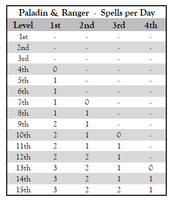
Homebrew Aerth
RULES and CHANGES
WHAT'S ALL THIS, THEN?
These are additional rule updates and changes, plus additions to lists and resources, that I felt enhance game play in the world I run.
While I feel Dungeons and Dragons reached its pinnacle with the 3.5 edition, there were some things that I thought should have been kept from previous editions, changes I felt were unnecessary, as well as enhancements from Pathfinder 1E or other 3rd parties.
HIT POINTS
• Max at 1st level as listed in the rules.
• Every level thereafter, when a roll is under the minimum below, the player can take the minimum listed, or roll again and is required to use the roll no matter the outcome.
Min — Hit Die
2 — d4 Sorcerer, wizard
3 — d6 Bard, rogue
4 — d8 Cleric, druid, monk, ranger
5 — d10 Fighter, paladin
6 — d12 Barbarian
CHARACTERS
• Fighter's Class Features: When comparing the fighter to other martial classes, Barbarian, Paladin, or Ranger, the Bonus Feats hardly make up for the lack of additional class features, Skill availability, and more. In previous editions the fighter was compensated by a faster level progression and/or exclusivity to various skills.
In an effort to make up for some of the shortfalls, I borrowed from Pathfinder 1E for additional class features as shown in the chart below.

• Paladin's Mount: A paladin may call for his Special Mount upon reaching 5th level, or anytime thereafter. This faithful steed need not be a horse; it may be whatever sort of creature is appropriate to the character (as decided with the DM). A paladin's mount is a very special animal, bonded by fate to the warrior. The paladin does not really "call" the animal, nor does the mount instantly appear in front of him. Rather, the character must find his mount in some memorable way, most frequently by a specific quest.
Should the paladin's mount die, she may call for another one after a year and a day. The new mount has all the accumulated abilities due a mount of the paladin's level.
(This rule is a throwback to OSR. The Pokémon aspect of the the Paladin's Mount in 3.5E rules always struck me as a weird class ability, unlike any of the other classes who have companions or familiars.)
SKILLS
• Heal: With the use of a Healer's Kit, someone administering successful First Aid (DC15) within 5 minutes of the injury, allows for healing of 1d3 damage per combat. No retry is possible and it always expends one use from the Healer's Kit. (I don't believe this should have been dropped in the transition from 2E.)
SPELLS AND CASTING
• Paladins and Rangers use the modified charts from Pathfinder 1E to facilitate slightly faster progression.

• Spell casters, aside from Bards and Sorcerers, prepare a list of spells for each spell level from which they can spontaneously cast as they choose.
For example, a 2nd-level Cleric with a 14 Wisdom would prepare four different 0-level spells and three different 1st-level spells.
During that day, they can cast any combination of those four 0-level spells a total of four times, and any combination of those three 1st-level spells a total of three times.
They could theoretically cast three Light Spells and one Guidance, if they prepared Create Water, Guidance, Light, and Virtue at the beginning of their day.
COMBAT
• As in Pathfinder 1E, when performing special attacks such as Bull Rush, Disarm, Grapple, et al., an opponent's successful AoO does not result in complete failure, but adds a penalty equal to the damage sustained.
• Rolling a Natural 20 while Confirming a Critical Hit results in maximum weapon damage without rolling (extra dice from Sneak Attacks or weapon abilities such as Fire or Frost are never multiplied).
INJURY AND DEATH
• On the next turn after a character is reduced to between -1 and -9 hit points and on all subsequent turns, roll d% to see whether the dying character becomes stable. They have a % chance equal to their Constitution score of becoming stable. If they don't, they lose 1 hit point. The % chance equal to their Constitution score also applies to Recovering with, or without, Help rules.